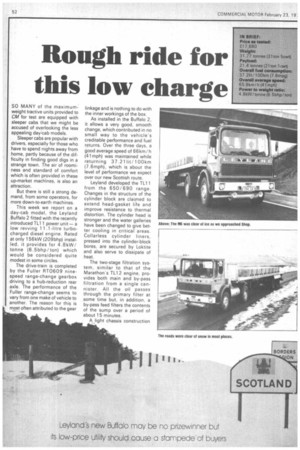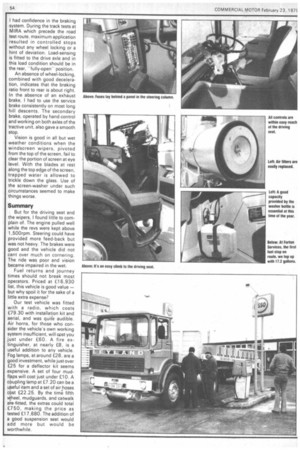Rough ride for this low charge
Page 54

Page 55

Page 56

If you've noticed an error in this article please click here to report it so we can fix it.
SO MANY of the maximumweight tractive units provided to CM for test are equipped with sleeper cabs that we might be accused of overlooking the less appealing day-cab models.
Sleeper cabs are popular with drivers, especially for those who have to spend nights away from home, partly because of the difficulty in finding good digs in a strange town. The air of roominess and standard of comfort which is often provided in these up-market machines, is also an attraction.
But there is still a strong demand, from some operators, for more down-to-earth machines.
This week we report on a day-cab model, the Leyland Buffalo 2 fitted with the recently introduced TL11 power unit — a low revving 11.1-litre turbocharged diesel engine. Rated at only 156kW (209bhp) installed, it provides for 4.8kW/ tonne (6.5bhp/ ton) which would be considered quite modest in some circles.
The drive-train is completed by the Fuller RT0609 ninespeed range-change gearbox driving to a hub-reduction rear axle. The performance of the Fuller range-change seems to vary from one make of vehicle to another. The reason for this is most often attributed to the gear linkage and is nothing to do with the inner workings of the box.
As installed in the Buffalo 2, it allows a very good, smooth change, which contributed in no small way to the vehicle's creditable performance and fuel returns. Over the three days, a good average speed of 66km/ h (41 mph) was maintained while returning 37.21lit/100km (7.6mph), which is about the level of performance we expect over our new Scottish route.
Leyland developed the TL11 from the 650/690 range. Changes in the structure of the cylinder block are claimed to extend head-gasket life and improve resistance to thermal distortion. The cylinder head is stronger and the water galleries have been changed to give better cooling in critical. areas. Collarless cylinder liners, pressed into the cylinder-block bores, are secured by Loktite and also serve to dissipate of heat.
The two-stage filtration system, similar to that of the Marathon's TL12 engine, provides both main and by-pass filtration from a single cannister. All the oil passes through the primary filter at some time but, in addition, a by-pass feed filters the contents of the sump over a period of about 15 minutes.
A light chassis construction employing high-tensile straightsided chassis frame contributes to the tractive unit's low unladen weight of 5.7 tons,
The cab shell has had a long production run and is expected to be replaced in the nottoo-distant future. Updating the interior has already extended its life once. It has been called -ergonomic cab", probably because all the controls are close to hand. It has the facility to tilt to 30deg, but not for casual inspection of the engine. To raise the cab, the driving seat must first be removed to allow clearance for the steering column, which remains static.
Two bolts must be slackened off with spanners before the manual pump can be operated to lift it. Providing the bolts do not get rusted up, the whole procedure may be completed in only a few minutes.
Normal oil dip-stick checks are made beneath a hinged engine cowl which doubles as a document tray. Two storage lockers positioned above the windscreen blend neatly into the roof trim.
The weather was not the best I have encountered on a road test, but at least the wind remained light. On the A5 and other A-road sections, the effects of winter salting are very evident: the road surface is breaking up badly in places.
The occasional rough road conditions made me aware just how basic the driver's seat is. The back-rest is too vertical, giving little support, while the adjustable suspension mechanism proved inadequate, both points contributing to my discomfort.
All controls, some out of view, could easily be reached from the driving position. The steering is light bot too insensitive, without much feed-back from the road. The gearbox was a pleasure to use and because power ouput is lower than many vehicles we have had for test recently, it was used more.
I was advised at the outset that the best results would be obtained if engine revs were kept within the 1,5002,00Orpm range. For the most part I followed these instruc tions, except on the hilly sections where it paid to change to a lower gear at about 1,600rpm. Forty miles per hour in top gear equates to 1,350rpm which is also the point of peak torque, so that any slight rise in the road resulted in a drop in engine speed and made the use of a lower gear necessary.
From inside the cab, engine noise was not a problem. It is well suppressed by baffle plates and fibreglass insulation material below the cowling..
An early start to the second day saw us on the road before dawn, which meant that we en countered icy conditions in the dark, A can of de-icing fluid quickly cleared the windows and once on our way, the vehicle's heating system was soon warm enough to keep them clear.
We were less fortunate with road conditions on the M6 and had to proceed with extreme caution for some way past our fuel stop at Forton. On the way we passed half a dozen or more car drivers who, not appreciating the seriousness of the conditions, were awaiting the arrival of a recovery vehicle to remove their vehicles from the central reservation or the ditch. Naturally the time taken over this section is slow, but it did not affect the overall average speed by much.
Even under these conditions,
I had confidence in the braking system. During the track tests at MIRA which precede the road test route, maximum application resulted in controlled stops without any wheel locking or a hint of deviation. Load-sensing is fitted to the drive axle and in this load condition should be in the rear, "fully-openposition.
An absence of wheel-locking, combined with good deceleration, indicates that the braking ratio front to rear is about right. In the absence of an exhaust brake, I had to use the service brake consistently on most long hill descents. The secondary brake, operated by hand control and working on both axles of the tractive unit, also gave a smooth stop.
Vision is good in all but wet weather conditions when the windscreen wipers, pivoted from the top of the screen, fail to clear the portion of screen at eye level. With the blades at rest along the top edge of the screen, trapped water is allowed to trickle down the glass_ Use of the screen-washer under such circumstances seemed to make things worse.
Summary
But for the driving seat and the wipers, I found little to complain of. The engine pulled well while the revs were kept above 1,500rpm. Steering could have provided more feed-back but was not heavy. The brakes were good and the vehicle did not cant over much on cornering. The ride was poor and vision became impaired in the wet.
Fuel returns and journey times should not break most operators. Priced at £16,930 list, this vehicle is good value — but why spoil it for the sake of a little extra expense?
Our test vehicle was fitted with a radio, which costs £79.30 with installation kit and aerial, and was quife audible. Air horns, for those who consider the vehicle's own working system insufficient, will cost you just under £60. A fire extinguisher, at nearly £8, is a useful addition to any vehicle. Fog lamps, at around E28, are a good investment, while just over £25 for a deflector kit seems expensive. A set of four mudflaps will cost just under £1 0. A coupling lamp at £7.20 can be a useful item and a set of air hoses cost E22.25. By the time fifth wheel, mudguards, and catwalk are fitted, the extras could total £750, making the price as tested El 7,680. The addition of a good suspension seat would add more but would be worthwhile.




























































































































